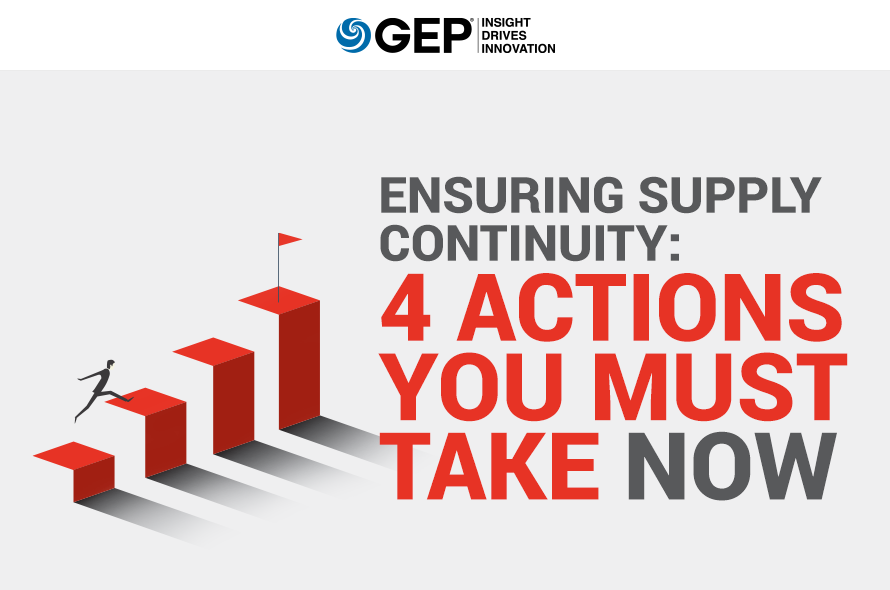Was your company walloped when China’s businesses and factories shut down in the wake of the coronavirus outbreak? Is there anything you can do to keep this from happening again?
The answer is yes. Companies can learn from this unsettling experience, and there are several key things leaders should do today.
Our latest GEP Bulletin — Ensuring Supply Continuity: 4 Actions You Must Take Now to Mitigate Supply Risks — contains your action plan for making your business more resilient and your supply chain more durable.
Diversifying supply sources, keeping closer tabs on Tier 2 suppliers, obtaining the right insurance coverage — these should all be part of your strategy, and we’ll explain exactly why.
Now that you’ve seen what overreliance on one geographic region can cost you — take the necessary steps to mitigate this risk and put the right safeguards in place.
Get guidance now.
China has long been known as a mass producer of merchandise exported to countries throughout the world. Additionally, it’s a huge global supplier of parts and raw materials. The country is the logistics and manufacturing center of the world with exports worth more than $2.5 trillion. Companies across industries are extremely dependent on China, thanks to the cost advantages. Disney, Nike, McDonald’s, Hyundai, Amazon — these are just a few of the big names that rely on China’s efficient factories.
But the outbreak of the coronavirus epidemic in China shut businesses and factories tight and caused widespread flight cancellations. These actions have resulted in production disruptions in companies globally. Around 22 million businesses within China have been affected by COVID-19. This is likely to affect at least 56,000 companies around the world.
The coronavirus outbreak in China — and now, globally — has disrupted almost all major industries: food, fashion and entertainment, automobiles, technology, and so forth. Fiat Automobiles has said it’s suspending production at a car factory in Serbia because of its inability to get parts from China. Hyundai has decided to likewise halt production at its plants in Korea due to disruptions in the supply of parts from China. Procter & Gamble has 387 suppliers in China that ship 9,000 materials around the world — about 17,600 products are in jeopardy.
According to a global investment advisory, BCA Research, global growth is expected to drop to 0% in Q1 of 2020. Commodity markets are undergoing a consumer demand slowdown.
Can companies stem the tide of a likely downturn from China’s shutdown? What can companies learn from this experience?
To start, companies should take steps to mitigate risk and prevent future supply chain disruptions in times of crisis. These steps include:
- Establishing an alternative supply base
- Moving away from heavy reliance on single-source suppliers
- Managing risk for a minimum of Tiers 1 and 2 in supply chains
- Purchasing insurance coverage
ESTABLISHING AN ALTERNATIVE SUPPLY BASE
Companies should reduce dependence on one geographic region. Some are already looking toward suppliers in countries like Mexico and Vietnam as potential future supply bases for production materials. Reducing dependence on China makes a lot of sense. U.S. producers have stepped up plans to reduce reliance on China. Companies in 10 out of 12 global industries, including semiconductors, automotive and medical equipment, have already moved, or plan to move, supply chains at least partially from China.
AVOIDING RELIANCE ON SINGLE-SOURCE SUPPLIERS
It’s important to redesign the supply chain with secondary sources. Companies that relied heavily or solely on factories in China for parts and materials have been hardest hit. This has had a cascading effect through supply chains, even affecting companies that don’t directly source materials or products themselves from China, but whose suppliers do.
MONITORING TIERS 1 AND 2 IN SUPPLY CHAINS
Companies should invest in monitoring and mapping their global suppliers. Supply chain mapping is the process of engaging suppliers to document the exact source of every material, every process and every shipment involved in bringing products to market. The process helps enterprises to understand their global sites and subcontractors, as well as to determine which parts originate or pass through those sites. Companies could also map suppliers’ manufacturing, warehouse, and distribution sites so that they don’t all cluster in the same region.
Companies should try to manage risk not just for Tier 1 but also for Tier 2 suppliers. Companies should also make sure their Tier 1 suppliers have robust risk management programs — they should be mapping and monitoring their own suppliers, adding alternate sources for those at highest risk.
A vast majority of global companies are surprisingly oblivious to the locations of second- and third-tier suppliers who provide parts to their direct suppliers, and therefore were caught off guard by the effects on second- and third-tier suppliers after the crisis set in.
BUYING INSURANCE COVERAGE
Business interruption and other losses due to the coronavirus pandemic are projected to total in the billions of dollars. To guard against similar disruptions at critical suppliers’ sites, enterprises should buy insurance to cover their profits. Commercial policyholders should proactively review their insurance coverage provisions to guard against risk of the coronavirus and other infectious disease-related losses.
As the coronavirus crisis continues, the challenges of supply chain management are only going to intensify. It may be worth finding a partner with deep experience in procurement and supply chain management to reinforce your capabilities and help you stay the course.
If you would like to have a conversation about how we can help, please reach out to our supply chain leadership.
Let’s talk.

ERIC WILSON
General Manager, Supply Chain and Technology Services
Eric brings over 20 years of leadership experience in enterprise business applications, including over 13 years specializing in SaaS source-to-pay and supply chain solutions. He leads global cross-functional teams that are responsible for building, delivering and supporting the next generation of intelligent supply chain and digital procurement solutions.

